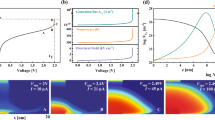Abstract
The authors investigate the conduction filament (CF) formation voltage and reset polarity dependence of a Ti/Zr\(\mathrm{O}_{2}\)/Pt resistive switching memory device on the Ti top electrode (TE) thickness by means of numerical simulation. A calculation method which accounts for both the initial statistical nature of the resistive switching layer (RSL) and the interaction of oxygen vacancies with oxygen species (O) on the overall conductance is used. The results show a correlation between the TE thickness and the density profile of O species both along the RSL–TE interface and within the TE, and indentify the causes for the previously observed not yet fully comprehended TE thickness dependent functionality of this device. The authors demonstrate that accumulation and reduction of O, during forming, result in a charged interfacial layer which decreases the effective oxide thickness and determines the forming voltage and switching polarity. In addition, local temperature profiles within the CF during forming promote O diffusion into the TE material which reduces the local conductivity and affects the forming voltage magnitude as well. In addition the authors provide forming and reset calculations for TE thicknesses of 5, 20 and 40 nm which are in good agreement with published experimental data.









Similar content being viewed by others
References
Tseng, T.Y., Sze, S.M.: In: Tseng, T.Y., Sze, S.M. (eds.) An Introduction to Nonvolatile Memories in Nonvolatile Memories: Materials, Devices, and Applications, pp. 1–9. American Scientific Publishers, California (2012)
Wong, H.-S.P., Lee, H.Y., Yu, S., Chen, Y.S., Wu, Y., Chen, P.S., Lee, B., Chen, F.T., Tsai, M.J.: Metal-oxide RRAM. Proc. IEEE 100(6), 1951–1970 (2012). doi:10.1109/JPROC.2012.2190369
Lin, C.Y., Wu, C.Y., Wu, C.Y., Lee, T.C., Yang, F.L., Tseng, T.Y., Hu, C.M.: Effect of top electrode material on resistive switching properties of \(ZrO_{2}\) film memory devices. IEEE Electron. Device Lett. 28, 366 (2007). doi:10.1109/LED.2007.894652
Lin, C.Y., Wu, C.Y., Wu, C.Y., Tseng, T.Y., Hu, C.: Modified resistive switching behavior of \(ZrO_{2}\) memory films based on the interface layer formed by using Ti top electrode. J. Appl. Phys. 102, 094101 (2007). doi:10.1063/1.2802990
Wang, S.Y., Lee, D.Y., Tseng, T.Y., Lin, C.Y.: Effects of Ti top electrode thickness on the resistive switching behaviors of rf-sputtered \(ZrO_{2}\) memory films. Appl. Phys. Lett. 95, 112904 (2009). doi:10.1063/1.3231872
Lin, C.Y., Wu, C.Y., Wu, C.Y., Tseng, T.Y., Hu, C.: Modified resistive switching behavior of \(ZrO_{2}\) resistive switching thin film. J. Electrochem. Soc. 155, H615–H619 (2008)
Berco, D., Tseng, T.Y.: A comprehensive study of bipolar operation in resistive switching memory devices. J. Comput. Electron. (2015). doi:10.1007/s10825-015-0736-7
De Stefano, F., Houssa, M., Afanas’ev, V.V., Kittl, J.A., Jurczak, M., Stesmans, A.: Nature of the filament formed in \(H\,fO_{2}\)-based resistive random access memory. Thin Solid Films 533, 15–18 (2013)
Bregolin, F.L., Behar, M., Dyment, F.: Diffusion study of O implanted into Ti using the nuclear resonance technique. Appl. Phys. A 86, 481–484 (2007)
Brossmann, U., Knoner, G., Schaefer, H.-E., Wurschum, R.: Oxygen diffusion in nanocrystalline \(ZrO_{2}\). Rev. Adv. Mater. Sci. 6, 7–11 (2004)
Harrop, P.J., Wanklyn, J.N.: The dielectric constant of zirconia. Br. J. Appl. Phys. 18, 739 (1967). doi:10.1088/0508-3443/18/6/305
Yu, S., Wong, H.-S.P.: A phenomenological model for the reset mechanism of metal oxide RRAM. IEEE Electron. Device Lett. 31(12), 1455–1457 (2010)
Acknowledgments
This work is supported by Ministry of Science and Technology, Taiwan, under Project No. NSC 102-2221-E-009-134-MY3.
Author information
Authors and Affiliations
Corresponding author
Rights and permissions
About this article
Cite this article
Berco, D., Tseng, TY. A numerical study of forming voltage and switching polarity dependence on Ti top electrode thickness in Zr\(\mathrm{O}_2\) RRAM. J Comput Electron 15, 595–601 (2016). https://doi.org/10.1007/s10825-015-0783-0
Published:
Issue Date:
DOI: https://doi.org/10.1007/s10825-015-0783-0




